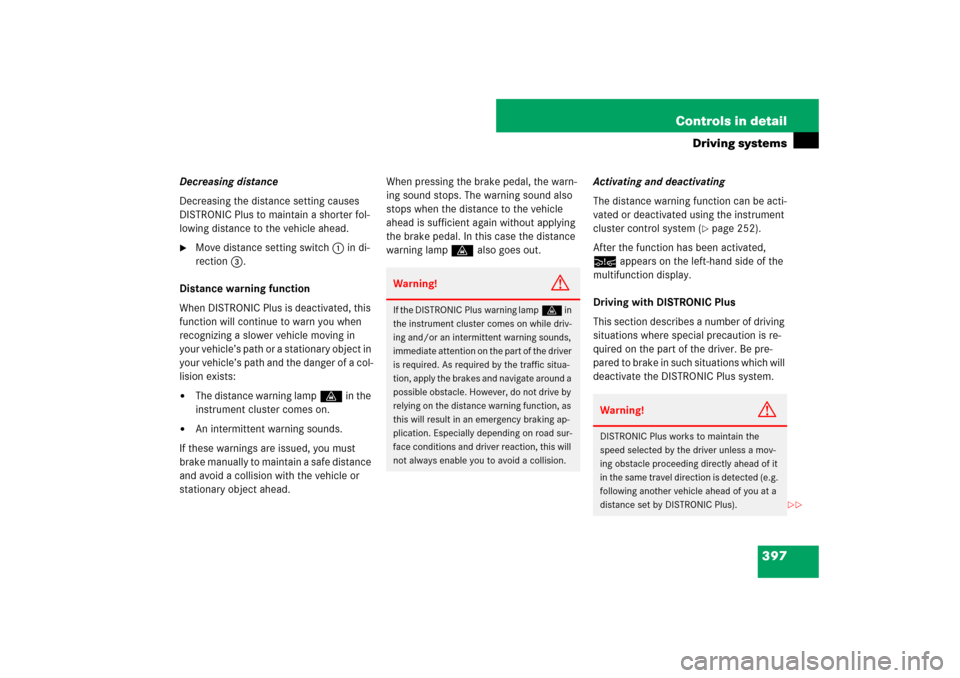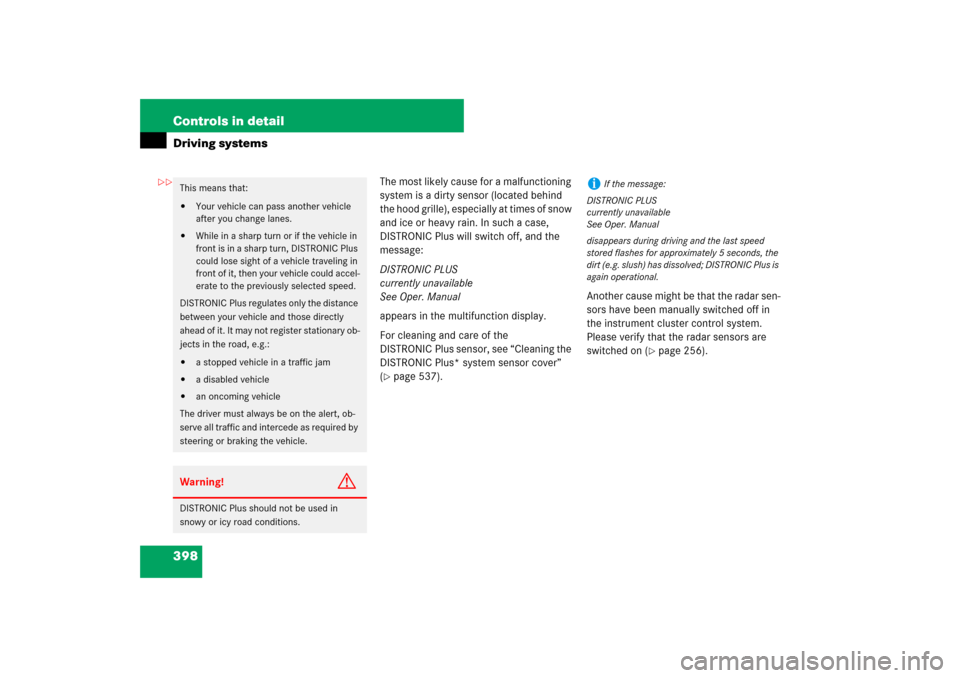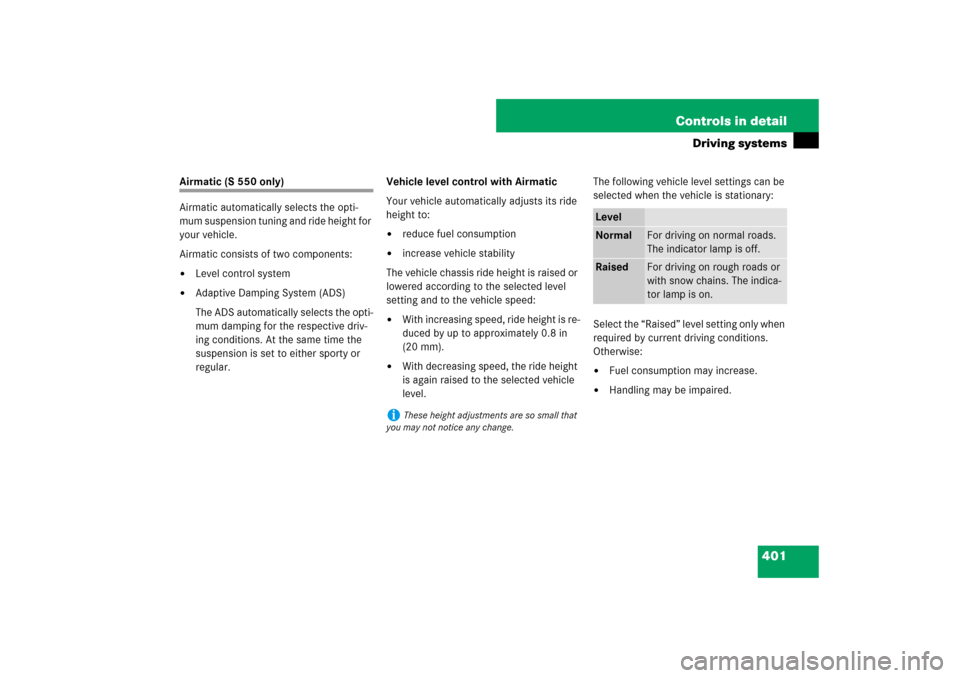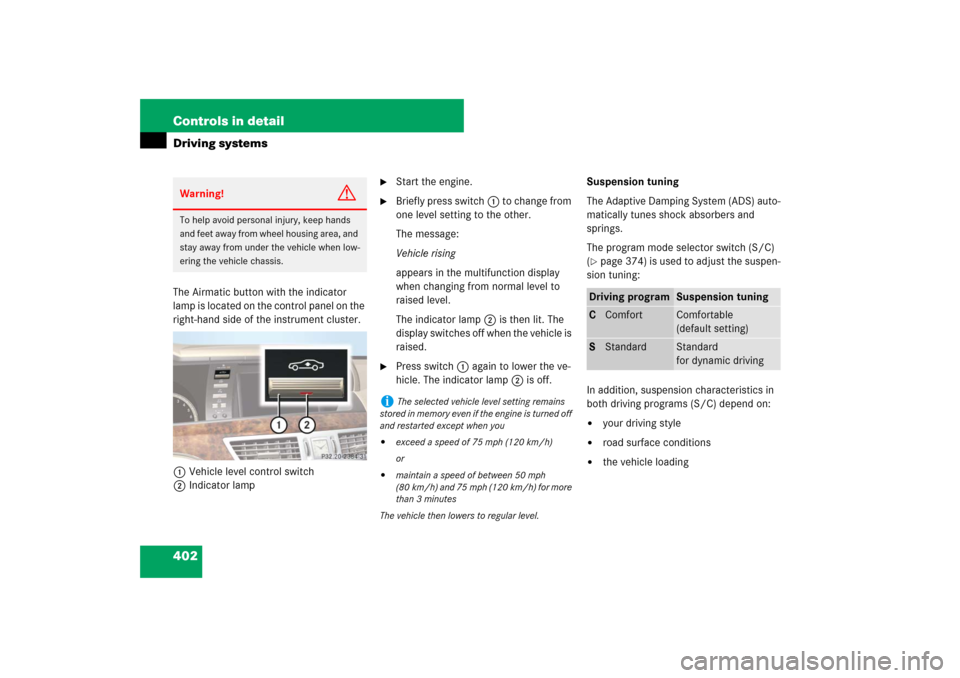Page 398 of 705

397 Controls in detail
Driving systems
Decreasing distance
Decreasing the distance setting causes
DISTRONIC Plus to maintain a shorter fol-
lowing distance to the vehicle ahead.�
Move distance setting switch 1 in di-
rection 3.
Distance warning function
When DISTRONIC Plus is deactivated, this
function will continue to warn you when
recognizing a slower vehicle moving in
your vehicle’s path or a stationary object in
your vehicle’s path and the danger of a col-
lision exists:
�
The distance warning lampl in the
instrument cluster comes on.
�
An intermittent warning sounds.
If these warnings are issued, you must
brake manually to maintain a safe distance
and avoid a collision with the vehicle or
stationary object ahead.When pressing the brake pedal, the warn-
ing sound stops. The warning sound also
stops when the distance to the vehicle
ahead is sufficient again without applying
the brake pedal. In this case the distance
warning lampl also goes out.Activating and deactivating
The distance warning function can be acti-
vated or deactivated using the instrument
cluster control system (
�page 252).
After the function has been activated,
: appears on the left-hand side of the
multifunction display.
Driving with DISTRONIC Plus
This section describes a number of driving
situations where special precaution is re-
quired on the part of the driver. Be pre-
pared to brake in such situations which will
deactivate the DISTRONIC Plus system.
Warning!
G
If the DISTRONIC Plus warning lampl in
the instrument cluster comes on while driv-
ing and/or an intermittent warning sounds,
immediate attention on the part of the driver
is required. As required by the traffic situa-
tion, apply the brakes and navigate around a
possible obstacle. However, do not drive by
relying on the distance warning function, as
this will result in an emergency braking ap-
plication. Especially depending on road sur-
face conditions and driver reaction, this will
not always enable you to avoid a collision.
Warning!
G
DISTRONIC Plus works to maintain the
speed selected by the driver unless a mov-
ing obstacle proceeding directly ahead of it
in the same travel direction is detected (e.g.
following another vehicle ahead of you at a
distance set by DISTRONIC Plus).
��
Page 399 of 705

398 Controls in detailDriving systems
The most likely cause for a malfunctioning
system is a dirty sensor (located behind
the hood grille), especially at times of snow
and ice or heavy rain. In such a case,
DISTRONIC Plus will switch off, and the
message:
DISTRONIC PLUS
currently unavailable
See Oper. Manual
appears in the multifunction display.
For cleaning and care of the
DISTRONIC Plus sensor, see “Cleaning the
DISTRONIC Plus* system sensor cover”
(�page 537).Another cause might be that the radar sen-
sors have been manually switched off in
the instrument cluster control system.
Please verify that the radar sensors are
switched on (
�page 256).
This means that:�
Your vehicle can pass another vehicle
after you change lanes.
�
While in a sharp turn or if the vehicle in
front is in a sharp turn, DISTRONIC Plus
could lose sight of a vehicle traveling in
front of it, then your vehicle could accel-
erate to the previously selected speed.
DISTRONIC Plus regulates only the distance
between your vehicle and those directly
ahead of it. It may not register stationary ob-
jects in the road, e.g.:
�
a stopped vehicle in a traffic jam
�
a disabled vehicle
�
an oncoming vehicle
The driver must always be on the alert, ob-
serve all traffic and intercede as required by
steering or braking the vehicle.
Warning!
G
DISTRONIC Plus should not be used in
snowy or icy road conditions.
i
If the message:
DISTRONIC PLUS
currently unavailable
See Oper. Manual
disappears during driving and the last speed
stored flashes for approximately 5 seconds, the
dirt (e.g. slush) has dissolved; DISTRONIC Plus is
again operational.
��
Page 400 of 705
399 Controls in detail
Driving systems
Turns and bends
In turns or bends, DISTRONIC Plus may not
detect a moving vehicle in front, or it may
detect one too soon. This may cause your
vehicle to brake late or unexpectedly.Offset driving
A vehicle traveling in your lane but offset
from your direct line of travel may not be
detected by DISTRONIC Plus. There will be
insufficient distance to the vehicle ahead.Lane changing
DISTRONIC Plus has not yet detected the
vehicle changing lanes. There will be insuf-
ficient distance to the lane-changing vehi-
cle.
Page 401 of 705
400 Controls in detailDriving systemsNarrow vehicles
Because of their narrow profile, the vehi-
cles traveling near the outer edge of the
lane have not yet been detected by
DISTRONIC Plus. There will be insufficient
distance to the vehicles ahead.Obstacles and stationary vehicles
DISTRONIC Plus does not brake for obsta-
cles or stationary vehicles. If, for example,
the vehicle detected in front of you chang-
es lanes to bypass an obstacle or station-
ary vehicle in front of it, DISTRONIC Plus
will not brake for the obstacle or stationary
vehicle.Cross-traffic
DISTRONIC Plus may inadvertently detect
crossing vehicles. If you switch on DIS-
TRONIC Plus, for example, at a traffic light
with cross-traffic, the vehicle may sudden-
ly start to drive off.
Page 402 of 705

401 Controls in detail
Driving systems
Airmatic (S 550 only)
Airmatic automatically selects the opti-
mum suspension tuning and ride height for
your vehicle.
Airmatic consists of two components:�
Level control system
�
Adaptive Damping System (ADS)
The ADS automatically selects the opti-
mum damping for the respective driv-
ing conditions. At the same time the
suspension is set to either sporty or
regular.Vehicle level control with Airmatic
Your vehicle automatically adjusts its ride
height to:
�
reduce fuel consumption
�
increase vehicle stability
The vehicle chassis ride height is raised or
lowered according to the selected level
setting and to the vehicle speed:
�
With increasing speed, ride height is re-
duced by up to approximately 0.8 in
(20 mm).
�
With decreasing speed, the ride height
is again raised to the selected vehicle
level.The following vehicle level settings can be
selected when the vehicle is stationary:
Select the “Raised” level setting only when
required by current driving conditions.
Otherwise:
�
Fuel consumption may increase.
�
Handling may be impaired.
i
These height adjustments are so small that
you may not notice any change.
LevelNormal
For driving on normal roads.
The indicator lamp is off.
Raised
For driving on rough roads or
with snow chains. The indica-
tor lamp is on.
Page 403 of 705

402 Controls in detailDriving systemsThe Airmatic button with the indicator
lamp is located on the control panel on the
right-hand side of the instrument cluster.
1Vehicle level control switch
2Indicator lamp
�
Start the engine.
�
Briefly press switch1 to change from
one level setting to the other.
The message:
Vehicle rising
appears in the multifunction display
when changing from normal level to
raised level.
The indicator lamp2 is then lit. The
display switches off when the vehicle is
raised.
�
Press switch1 again to lower the ve-
hicle. The indicator lamp2 is off.Suspension tuning
The Adaptive Damping System (ADS) auto-
matically tunes shock absorbers and
springs.
The program mode selector switch (S/C)
(
�page 374) is used to adjust the suspen-
sion tuning:
In addition, suspension characteristics in
both driving programs (S/C) depend on:
�
your driving style
�
road surface conditions
�
the vehicle loading
Warning!
G
To help avoid personal injury, keep hands
and feet away from wheel housing area, and
stay away from under the vehicle when low-
ering the vehicle chassis.
i
The selected vehicle level setting remains
stored in memory even if the engine is turned off
and restarted except when you
�
exceed a speed of 75 mph (120 km/h)
or
�
maintain a speed of between 50 mph
(80 km/h) and 75 mph (120 km/h) for more
than 3 minutes
The vehicle then lowers to regular level.
Driving program
Suspension tuning
CComfort
Comfortable
(default setting)
SStandard
Standard
for dynamic driving
Page 404 of 705

403 Controls in detail
Driving systems
Active Body Control (ABC)*
The ABC system automatically selects the
optimum suspension tuning and ride
height for your vehicle.
The ABC system consists of an active, hy-
draulically controlled suspension and
damping system.
Vehicle level control with ABC*
Your vehicle automatically adjusts its ride
height to:�
reduce fuel consumption
�
increase vehicle stability
The vehicle chassis ride height is raised or
lowered according to the selected level
setting and to the vehicle speed:
�
With increasing speed, ride height is re-
duced by up to approximately 0.6 in
(15 mm).
�
With decreasing speed, the ride height
is again raised to the selected vehicle
level.The following vehicle level settings can be
selected when the vehicle is stationary:
Select the “Raised” level setting only when
required by current driving conditions.
Otherwise:
�
Fuel consumption may increase.
�
Handling may be impaired.
i
These height adjustments are so small that
you may not notice any change.
LevelNormal
For driving on normal roads.
The indicator lamp is off.
Raised
For driving on rough roads or
with snow chains. The indica-
tor lamp is on.
i
The selected vehicle level setting remains
stored in memory even if the engine is turned off
and restarted.
Warning!
G
To help avoid personal injury, keep hands
and feet away from wheel housing area, and
stay away from under the vehicle when low-
ering the vehicle chassis.
Page 405 of 705
404 Controls in detailDriving systemsThe ABC level control switch with the indi-
cator lamp is located on the control panel
on the right-hand side of the instrument
cluster.
1Vehicle level control switch
2Indicator lampSelecting a higher level
�
Start the engine.
If indicator lamp2 is off:
�
Press switch1.
Indicator lamp2 comes on. The vehi-
cle is raised to a higher level.
Selecting a normal level
�
Start the engine.
If indicator lamp2 is on:
�
Press switch1.
Indicator lamp2 goes out. The vehicle
is adjusted to a normal level.Suspension tuning
The program mode selector switch (C/S)
(
�page 374) is used to adjust the suspen-
sion tuning:
In addition, suspension characteristics in
both driving programs (S/C) depend on:
�
your driving style
�
road surface conditions
�
the vehicle loading
Driving program
Suspension tuning
CComfort
Comfortable
(default setting)
SStandard
Standard
for dynamic driving